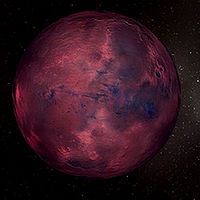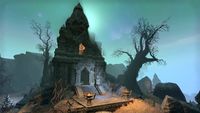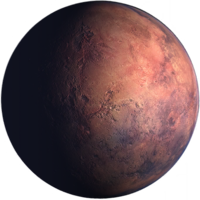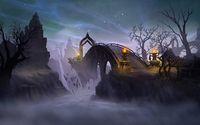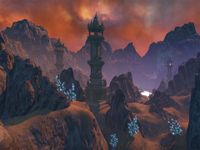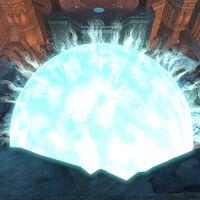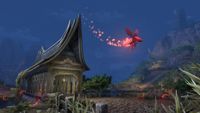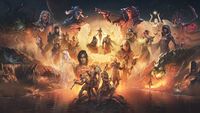Lore:Masser
| Masser | |
|---|---|
| Type | Moon |
| Realm | Mundus |
Masser, also known as Jode, Mara's Tear and Zennji in Ta'agra,[1] is the greater of Nirn's two moons and is acknowledged as one of the attendant spirits of the mortal plane. As such, it is both temporal and subject to the bounds of mortality. As with all astral bodies seen from Nirn, the moons and dominion planets, Masser is said to actually be a separate plane in its own right, infinite in size and mass, with its appearance as a sphere being only a visual phenomenon caused by mortal mental stress. Masser has long since perished and its death has led to mortals perceiving its previously pure white and featureless sphere as having its current texture and reddish hue, the moon's "skin" withering away.[UOL 1]
Members of the Mages Guild have described the moons as islands in the sky.[2]
Culture[edit]
Masser received its title from the Aldmer, who knew the plane as Jode ("Big Moon God" in Ehlnofex). Similarly, Masser finds itself invested with a position of authority and reverence among the Khajiiti pantheon, as its phase at the time of their birth — along with that of Secunda, the lesser of Nirn's moons — determines their form.
While regarded by various cultures as an attendant spirit of their god planet, minor god, or foreign god, Masser is not displayed within Dwemer orreries, nor does it hold a position within the pantheon of Imperial gods.
Some believe that the moons stand as testament to the potency of twins in Tamrielic mythology.[3] Indeed, it is not rare for them to be referred to as the Twin Moons.[4][5][6][7][8]
Khajiit[edit]
For the Khajiit, the moons have special significance in their culture. In Khajiiti legend, the motion of the moons constructs something called the "Lunar Lattice" or "Ja-Kha'jay" in Ta'agra, which protects Mundus from the rest of the Aurbis.[9] Khajiit are born in differing forms depending on the current phases of the moons. They will often refer to specific moon phases by the Khajiiti form it is connected to.[10][11] See Khajiiti Morphology for details. Just as Khajiit are the children of Jone and Jode, the Drom-m'Athra are children of the Dark Moon.[12] Their influence is stronger when the moons are new and in tall places close to the moons, and to speak of them outside the moonlight risks their corruption.[13][14] Forgotten Manes, those born under the eclipse, called to become champions of the Pride of Alkosh are more closely linked to the moons but also at greater risk of corruption.[15][16]
Pre-ri'Datta[edit]
In pre-ri'Datta Khajiiti culture, Jode is known under the title of the Ever-mourned, and is one of the two stillborn twins of Fadomai. As Fadomai was dying, Khenarthi didn't want her mother to despair in knowing of her twin's fate, and kept it to herself.[17] The twins are known as the Twin Lanterns of Jone and Jode.[17] Jode is known as the lantern of love, who is "as hot and red as summer solstice", and its twin Jone is the lantern of mercy, who is as "cool and pale as a winter moon".[18][19] These lanterns were lit to give the illusion of their eyes being bright and full of life. Khenarthi then embraced them, and rocked them in the sky until her mother passed. Azurah looks after them now and ensures their fires are kept lit, relighting the lanterns when they burn low,[17] while the spirit Alkosh ensures their movement with the tapestry of time, ensuring that they are not locked in place to prevent the undesirable from slipping through the Lunar Lattice.[19] The Twin Lantern's love for the Khajiiti people is expressed through Moonlight and Moon Sugar.[17]
Pre-ri'Datta myths link a number of deities to the moons.
The Khajiit believe that Alkosh is responsible for preserving the stability of the world, as part of this role he is said to maintain the steady movement of the moons, Jode and Jone, it is believed that without him they would freeze in place, allowing terrible things to slip through the Lunar Lattice.[19] Hermorah and Azurah are also said to help maintain the motions of the moons in the sky.[20]
A number of myths describe a strong link between Azura and the moons. In Khajiiti culture, the First Secret given to Azurah by her mother Fadomai gives her dominion over the three moons, Jone, Jode,[9] and the Dark Moon.[21][22] She is said to have formed her own realm of Moonshadow out of a sea of moonlight tears she shed while grieving for her mother, and to have lit the fire the funeral pyre of Lorkhaj out of the lanters of love and mercy, of Jode and Jone, before scattering his ashes across the Lattice.[18] Other myths speak of how Azurah purred across the stars, coaxing the twin moons to part and make way for a sky-guardian, a third hidden moon which would serve as the shield of the Lunar Lattice, and shine down upon the Khajiit of purest heart and fervent obedience, who'd be known from that point on as the Litter of the Hidden Moon, and be tasked with redeeming the Dro-m'Athra.[21]
After Lorkhaj's death, Azurah made a funeral pyre before the Varliance gate, and lit it with the Twin Lanterns of Jone and Jode.[20][18] Her tears fell upon the pyre and the ashes scattered across the Lattice.[18] As a result, it is said Azurah and Khenarthi can call upon the "true spirit" of Lorkhaj to appear.[20] Sometime after the creation of the Khajiiti people, Azurah, knowing that the false Lorkhaj, the Moon Beast, a twisted shade born of the Dark Heart and the first Dro-m'Athra, would one day covet her children, used the Twin Lanterns of Jone and Jode to summon the true spirit of Lorkhaj to be a sky-guardian.[20][21] As the third moon, Lorkhaj shined his light upon the Khajiit, choosing the purest of heart to be part of the "Litter of the Hidden Moon", to learn the way of the Moonlight Blade.[21] And from then on, on nights of the Ghost Moon, Azurah opens the Void Gate, and the Moon Beast will challenge mortals until banished.[20] Furthermore, the spirit Boethra is said to wear the death-shroud of Lorkhaj these nights, and "wages war beyond the Lattice".[20] Modern Khajiiti beliefs on the third moon differ from ancient beliefs, with the birth of the Mane being the main purpose of its existence.[22] This belief could have existed since at least 1E 2902, with the earliest known mane.[23] Furthermore, the reasoning for the Dark Moon's existence is different. Modern Khajiit believe that Lorkhaj's body was hurled to the moons, and forced to follow Jone and Jode forever as punishment.[13] Regardless of beliefs, non Khajiit have difficulty seeing the Dead Moon due to their eyes.[13][10]
Pre-ri'Datta Khajiit myths speak of an alliance of the Adversarial Spirits Molagh, Merid-Nunda and Merrunz attacking the Lunar Lattice, only to be repelled by its defenders, Azurah, Boethra and Mafala who also receive the aid of Noctra. In such myths the Lattice is described as burning spirits that touch it, causing Molagh to fall into the darkness below when pressed against it. It is said that no spirit had ever managed to damage it until Merrunz, released in those myths to serve as a weapon against the Lattice, cracked it with his axe. Though the Adversarial Spirits are repelled, the myths describe this exact conflict and events having repeated many times in the past, so many even the deities involved don't recall the number.[20][24]
Other Beliefs[edit]
Some Moon-Singer songs link the moons to the origins of the Khajiiti demigod and hero Khunzar-ri. In the song, a young Shazeer Firstclaw, who would go on to become the first Clan Mother of the Barrukit kingdom, was cornered by a pride of hungry senche-lions while climbing on top of Shimmering Rise. She managed to hold them at bay with a stick and some pebbles until nightfall, when tiredness and hunger began to overtake her. Shazeer called to Jone and Jode for aid, and a moonbeam illuminated the rise. Within it stood a young Khajiit of the same age as Shazeer, who informed her that Jone and Jode had sculpted him out of moonlight, clouds, and her own courageous heart and sent him to rescue her. The Khajiit was Khunzar-ri, who proceeded to do as he'd promised.[25]
In modern Khajiit culture, walking the Path of Jode is a necessary step for a Lunar Champion seeking to become the Mane. Under the influence of moon sugar vapors, the Moon Hallowed guides the Lunar Champion through an aspect of Masser known as the Demi-Plane of Jode, which shapes itself to show visions of the future to those who walk along the path.[26][27][28]
The Lunar Lorkhan suggests that Masser originated as one of the halves of Lorkhan's "flesh-divinity", cast within the bounds of Nirn at the time of his destruction, and thus, is a personification of the dichotomy that Lorkhan legends often rail against: ideas of good versus evil, being versus nothingness, and so on. It is believed that Masser was thus purposefully set in the night sky as Lorkhan's constant reminder to his mortal issue of their duty.[29] The War of Manifest Metaphors suggest all claims as to the origins of the Moons are absurd.[30] Additionally, both modern and ancient Khajiiti religion places the two moons as separate entities that existed prior to Lorkhan's punishment,[9] and only believe that the third moon, the Dark Moon, is Lorkhaj's corpse.[13][10][12]
There is an ancient legend about a master jumper from Quin'rawl named Anahbi, who leapt from Nirn and almost fell into Oblivion but was caught by Jone and Jode. Anahbi quickly took the light from Jone and leapt for Nirn again. The two moons followed suit and danced across the skies to grab her. When they caught her again, she stole the light from Jode and tried to escape again, but they were able to restrain her. Anahbi promised to never do it again if they returned her home, and as a reminder of her promise, her brow bore speckles of stardust.[31]
The Tale of Dro'Zira, a Khajiit account of the Battle of Red Mountain describes how Ra'Wulfharth, who had been granted the "roar of Lorkhaj", spoke to the moons and commanded them to "move to their fullness in the sky" to turn a band of warriors from the Pride of Alkosh into senche and strip them of all reason, having them fight at his side, as he could not bring himself to kill them.[32]
The story of Rajhin and the Stone Maiden tells of the Trickster God preventing a young maiden from commiting suicide. Concerned, Rajhin asked her what would drive her to do such a thing, and she explained that her greedy step-father demanded an insane bride-price, and caused the village he ran to seethe with corruption. Seeking to teach the step-father a lesson, Rajhin aided the maiden in a plan that would allow her to be with her beloved. And so the couple met with the step-father to arrange a deal, and offered something greater than the bride-price. It was a great land that can be seen from their village that has no ruler. One that "shines like a pearl in the darkness", can be claimed, but cannot be reached without their agent. The greedy step-father agreed to the terms, which then prompted Rajhin to manifest behind him. As per their agreement, Rajhin quickly seized him and took him to the moon of Jode, far from where he could interfere with the couple's relationship. The villagers were initially shocked, but celebrated that their home was freed of the tyrant, and held a wedding ceremony for the couple. During the night, Rajhin manifested once more, for he traveled too fast which caused the step-father to be separated from his shadow, which threatened the newly-weds. Because they could not see it, from their perspective it appeared like Rajhin was reaching for air, and upon the Thief God's explanation, they were relieved and their laughter echoed across the riverbank.[33]
The ancient Khajiit moon priests practiced a rite known as the Shadow Dance or "Dance of Shadows", practiced famously by Anequina Sharp-Tongue and described as experiencing moonlight in its distilled form in order to "walk paths that took strange angles" to places "tangential to dreams, but never dreaming". Those attuned to the moons in this manner could "hear the moons sing" and could impact the Lunar Lattice, commanding the moons to move in the sky, open portals to other places and realms such as Oblivion, the Jonelight Path, or the moons themselves, and manipulate sources of lunar energy to perform deeds such as recharging a Dragonhorn. Descendants of the attuned could become linked to the spirits of their ancestor if they became attuned themselves, allowing them to perceive their memories and emotions and to act as vessels for them to act and communicate through should they desire it. Those who gained better understanding of their attunement learned how to "smell" magic and track and identify it by specific "scent", and gained greater mastery of portals, allowing them to open multiple portals in different locations at once and even imbue the portal magic into their blade and use it as a weapon in combat. Gazing into the eyes of a master of the Shadow Dance attuned to the moons was said to allow one to perceive the movement of their soul reflecting that of the moons and grant knowledge of it, the one transmitting such knowledge had to take care that only the reflection of the Lattice was glimpsed by the recipient, as witnessing the true glory and horror of the Lattice had driven many mad, despite this it is said that even the reflection allowed one to glimpse the bastion of existence, such that could not be found elsewhere. It was said that the reason the Dance could impact something as enormous as the Lattice was that, in truth, the Dance and the Lattice were of the same size, the movements of the attuned soul performing the Shadow Dance were a near perfect existence, a chaotic and beautiful movement "swelling with reverberations" of fumes of moonlight and the "great and small vertices", the moons mirrored and perfected that form, and so were themselves changed for a time. It is said that witnessing the Shadow Dance and the Lattice within the soul of the attuned directly could allow for true understanding of the Shadow Dance, though only those who'd undergone lifetimes of study could be shown this without risking madness. Some masters of the Shadow Dance such as Juha-ri Sage of the White Sand, were known to perform one final Shadow Dance at the end of their lives, causing them to collapse dead as their soul journeyed to the Sands Behind the Stars and leaving behind their temple acolytes. This last Shadow Dance took place within the vault of the Shadow Dance Temple where Anequina Sharp-Tongue herself danced the Shadow Dance.[34][35][36][37][38]
The Crimson Torchbug is said to be the light of Jode given form. These insects dance around Moon-Sugar Cane to bless the crops.[39]
Breton[edit]
A Breton story tells of two star crossed lovers, Shandar and Mara, children from different villages at war with one another. After seeking to run away from home, they were caught by the guards, and Shandar was imprisoned, while Mara was put in house arrest. Her father arranged a marriage to prevent the pair from getting married, which was further escalated by Shandar being scheduled for execution for daring to love Mara. Learning of this, Mara escaped into the wilds in the dark of night, at a time period where the moons didn't exist, and was kidnapped by an Orc during her sleep which planned to devour her.
The village learned of Mara fleeing from her home, yet they were too frightened to seek her out and confront the Orc. Shandar begged and was given the chance to go, but the village after gaining their composure realized that it was a mistake to send a child to confront a monster. They came across a clearing, seeing the corpse of the Orc and a mourning Mara holding the severed head of Shandar. With Mara's tears flowing down at his head, Shandar prayed to his lovers' namesake, and the goddess Mara responded. She did not have dominion over the death, and thus could not resurrect Shandar, but sought to keep their love alive. The goddess Mara reached down from the heavens and placed the lovers in the sky. They are now known as the moons Mara's Tear (Masser) and Shandar's Sorrow (Secunda), illuminating the night to keep away the evils that lurk.[40] This story complements the themes of the pre-ri'Datta Khajiit, with the moons fitting the sphere of the children's namesake, with Mara's Tear being a lantern of love, and Shandar's Sorrow being the lantern of mercy.[40]
Ancient druids had Mara's Tear and Shandar's Sorrow as a witness to sanctify rituals.[41][42]
Altmer[edit]
Three is one of the Sacred Numbers, which the Altmer recognize as integral to the universe's existence. Three, in particular, represents the Prime Celestials, which are embodied by the Sun and the two moons.[43]
Certain Altmer claim that it's common knowledge that the moons were created by Sheogorath.[2]
Argonian[edit]
Argonian alchemy uses the phases of the moon to precisely align the calcinator in the alchemical process. During the full moon, the calcinator faces south and aligns with the Southron pole star, and every night after that, the calcinator rotates clockwise one twenty-eighth of the circle. The device has to be placed in a way where the moonlight shines on half of it. During the new moon, the calcinator should be fully exposed to the light.[44] There is a town in southern Black Marsh called Moonmarch, which was east of Soulrest and southwest of Blackrose.[45]
Dunmer[edit]
The teachings of the Tribunal Temple describe a civilization of grave ghosts on a moon, known as the Parliament of Craters. They were said to hold resentment toward the kings of Nirn.[46]
Nord[edit]
Members of the Companions refer to someone afflicted with lycanthropy as "moon-born".[47][48]
In the "Five Songs of King Wulfharth", Nerevar's dagger, Keening was described as "made of the sound of the shadow of the moons".[49]
Reachfolk[edit]
Certain Reachfolk clans, like the Crow-Eyes, were known to present stones bathed in moonlight as offerings to their spirits to renew the protective wards surrounding their settlements, like Karthwasten. These moonlit rocks symbolized purity.[50][51][52] Additionally, silver is referred to as "moon-kissed ore" by the Reachfolk.[53] Furthermore, some clans even derive their names from the moon, as seen with the Black-Moon Clan.[54] Hircine oversees pacts between Reach clans, approving of the deal if the union is worth committing to. The ritual calling upon Hircine to bless a pact involves several components. On occasion, within these rituals, phrases like "Two great packs seek the same full moon. Make them one, bound by common prey" are intoned.[55][56]
Redguard[edit]
The crescent moon is a symbol of cultural significance in the Kingdom of Sentinel as it was the banner of Grandee Yaghoub, the one who first founded the capital city in the early-mid First Era.[57] The moon on the banner is known as the White Moon.[58] King Camaron was also called the White Moon as a nod to this.[59] Before the Order of the Candle was the knightly order of Sentinel, it was the Knights of the Moon.[citation needed]
The Aurbical Abacus was a Yokudan relic designed to track the movements of the moons, among other astronomical objects, and calculated the exact change in seasons. It was an artifact associated with Zeht, the god of agriculture, and kept in a tomb in Hew's Bane before it was later destroyed.[60]
Bosmer[edit]
The Bosmer regard the moons as spirits of fortune, both good and bad.[61]
Vampire[edit]
The moondial in Castle Volkihar is perhaps the only one in existence. It was originally a sundial built for the previous owners of the castle, but Valerica of the Volkihar Clan persuaded an elven artisan to change images of the sun to phases of the moons.[62]
One of Tamriel's most rare and dangerous artifacts is the Vampiric Ring. It was created in ancient times by a cult of vampires in Morrowind. Its rarity comes from the fact it only appears every few hundred moon cycles.[63]
Werewolf[edit]
Some strains of lycanthropy cause the afflicted to transform into a werewolf under moonlight,[64] or specifically a full moon.[65] Some of these werewolves worship the moons, but this practice has been considered a parody of true lunar faith.[66]
Other[edit]
Some sailors believe the moons were enormous atronachs, who wrestled for the amusement of the Daedric Princes, which is what causes thunderstorms.[2]
Gallery[edit]
References[edit]
- ^ Burnt Scripture
- ^ a b c Hireling Correspondence in ESO
- ^ Tamrielic Twins of Myth
- ^ Sacred Waters of the Shining Sea — Moon-Bishop Shavka
- ^ Pocket Guide to the Empire, 1st Edition: The Elsweyr Confederacy — Imperial Geographical Society, 2E 864
- ^ Meet the Character - Domihaus the Bloody-Horned — Gherig Bullblood
- ^ The Keepers of the Razor — Silus Vesuius
- ^ Kharjo's dialogue as a follower in Skyrim
- ^ a b c Words of Clan Mother Ahnissi — Clan Mother Ahnissi
- ^ a b c The Moon Cats and their Dance — Clan Mother Ahnissi
- ^ Mazurr's dialogue in ESO
- ^ a b Shazah's dialogue in ESO
- ^ a b c d Moon Bishop Hunal Answers Your Questions — Moon Bishop Hunal
- ^ Adara'hai's dialogue in ESO
- ^ Ja'darri's dialogue in ESO: Dragonhold
- ^ The Pride of Alkosh — Clan Mother Hizuni
- ^ a b c d The Sky Spirits — Amun-dro, the Silent Priest
- ^ a b c d The Favored Daughter of Fadomai — Amun-dro, the Silent Priest
- ^ a b c Moon-Bishop Azin-jo's dialogue in ESO: Elsweyr
- ^ a b c d e f g Spirits of Amun-dro — Amun-dro, the Silent Priest
- ^ a b c d The Tale of Three Moons
- ^ a b Vastarie's dialogue in ESO: Elsweyr
- ^ Shazah's dialogue on Mane Jinninji-ri in ESO
- ^ The Bladesongs of Boethra — Modun-Ra, the Hidden Voice
- ^ Khunzar-ri: Origin — Aneshi, Keeper of Legends for the 16 Kingdoms
- ^ Events of The Moonlit Path in ESO
- ^ Events of The Den of Lorkhaj in ESO
- ^ The Demi-Plane of Jode in ESO
- ^ The Lunar Lorkhan — Fal Droon
- ^ Den of Lorkhaj loading screen in ESO
- ^ A Dance in Moonlight
- ^ The Tale of Dro'Zira — Sonia Vette
- ^ Rajhin and the Stone Maiden
- ^ Khamira's dialogue in ESO
- ^ Cadwell's dialogue in ESO
- ^ Khunzar-ri's dialogue during the quest New Moon Rising in ESO
- ^ Chronicles of Juha-ri
- ^ Cadwell the Betrayer's dialogue and abilities in ESO
- ^ Crimson Torchbug pet description in ESO
- ^ a b Mara's Tear — Zhen
- ^ Druid King Kasorayn's dialogue in ESO
- ^ Elder Verline's dialogue in ESO
- ^ Thoughts on the Sacred Numbers
- ^ Calcinator Treatise
- ^ Moonmarch in Arena
- ^ 36 Lessons of Vivec, Sermon 16 — Vivec
- ^ Arnbjorn's dialogue in Skyrim
- ^ Aela the Huntress' dialogue in the quest "Glory of the Dead" in Skyrim
- ^ Five Songs of King Wulfharth
- ^ Shaman Ulvoch's dialogue in ESO: Markarth
- ^ Events of After the Storm in ESO: Markarth
- ^ Moon-Touched Stones item description in ESO: Markarth
- ^ Chief Ulvfae's dialogue in ESO: Markarth
- ^ Black-Moon Clan Camp in ESO: Markarth
- ^ Arana's dialogue in ESO: Markarth
- ^ Events of Blood of the Reach in ESO: Markarth
- ^ Sentinel, the Jewel of Alik'r — The Unveiled Azadiyeh, Songbird of Satakalaam
- ^ Sentinel ending description in Daggerfall
- ^ Daggerfall CES Cinematic
- ^ Naryu's Journal/Hew's Bane — Naryu Virian
- ^ Varieties of Faith: The Wood Elves — Brother Mikhael Karkuxor of the Imperial College
- ^ Serana's dialogue in the quest "Chasing Echoes" in Skyrim: Dawnguard
- ^ Tamrielic Lore — Yagrum Bagarn
- ^ Werewolf transformation mechanics in Morrowind: Bloodmoon
- ^ Werewolf transformation mechanics in Daggerfall
- ^ Moon Bishop Hunal Answers Your Questions — Moon Bishop Hunal
Note: The following references are considered to be unofficial sources. They are included to round off this article and may not be authoritative or conclusive.
|
|||||||||||
|
||||||||||||||||||||||||||
|
||||||||||||||||||||||||||||||||
